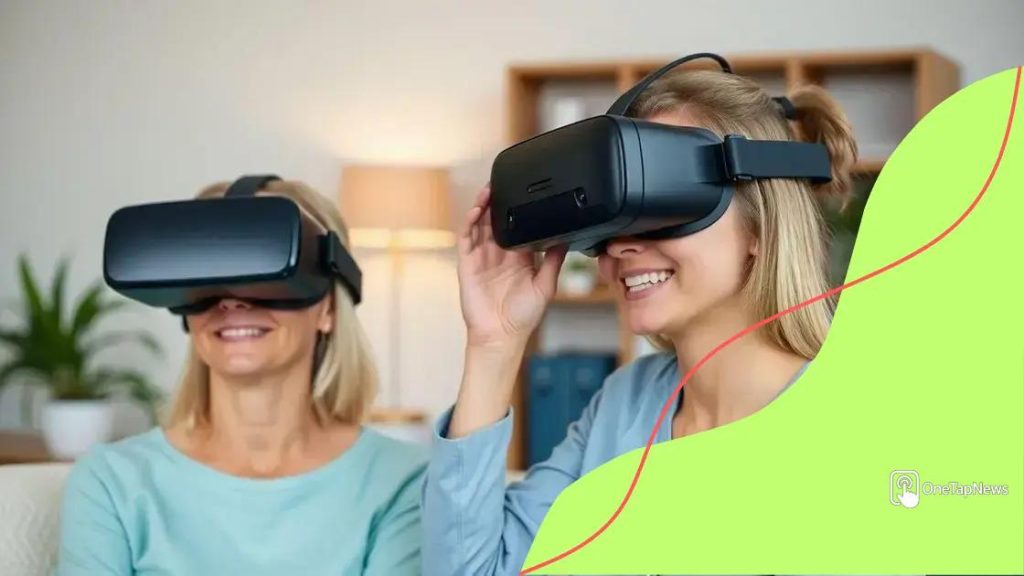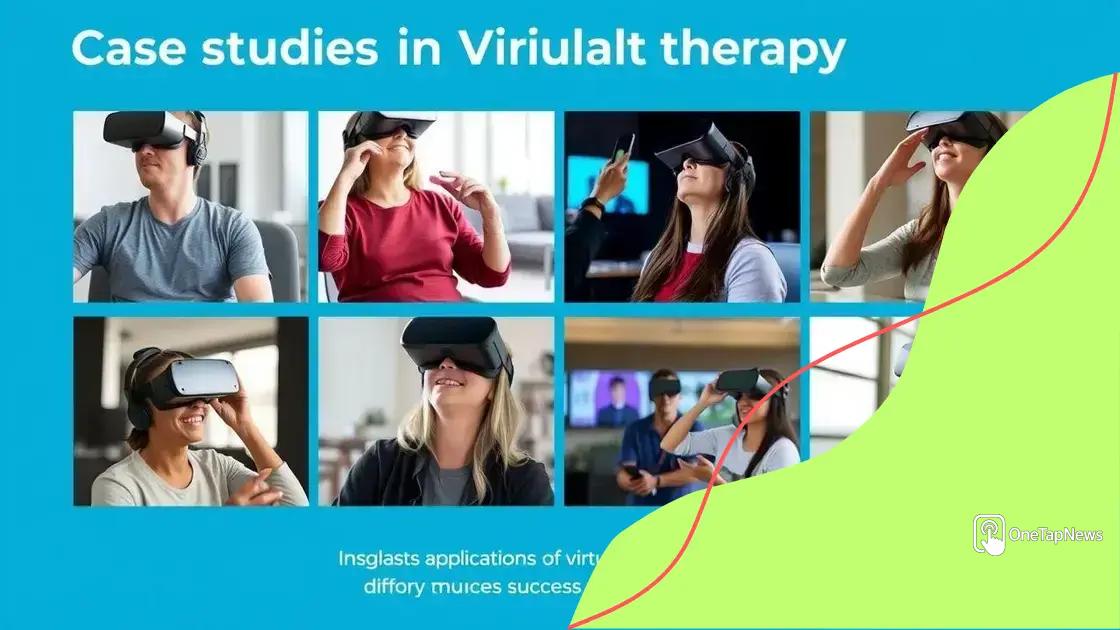Benefits of virtual reality in therapy for mental health

Anúncios
The benefits of virtual reality in therapy include enhanced patient engagement, customizable treatment scenarios, and increased accessibility to mental health care, making it a powerful tool for effective therapeutic interventions.
Benefits of virtual reality in therapy are becoming increasingly recognized in mental health treatment. Imagine being able to confront fears in a safe, controlled environment. This technology offers new avenues for healing and growth.
Anúncios
Understanding virtual reality in therapy
Understanding virtual reality in therapy opens up exciting possibilities for mental health treatment. By simulating real-life experiences, this technology allows patients to confront their fears in a safe and controlled environment. This immersive experience can be transformative for those struggling with anxiety, phobias, and PTSD.
What is Virtual Reality Therapy?
Virtual reality therapy uses computer-generated environments to create realistic scenarios. Patients wear headsets that allow them to explore these scenarios as if they were real. This can be particularly effective in exposure therapy, where individuals gradually face their fears.
How It Works
During a therapy session, a therapist guides the patient through various situations using virtual reality. For example, someone with a fear of heights may start by looking at a simulation of a low balcony. As they become more comfortable, the therapist can increase the difficulty, immersing them in even higher environments.
Anúncios
- Allows gradual exposure to fears
- Enhances patient engagement in therapy
- Provides immediate feedback in safe conditions
Patients often find that these immersive experiences help reduce their anxiety over time. It’s an innovative way to address mental health challenges, making therapy feel less daunting and more interactive.
Furthermore, virtual reality can enhance patients’ motivation to engage with their treatment. Unlike traditional methods, which may seem limited or repetitive, the dynamic nature of virtual reality keeps patients interested and invested in their progress.
Benefits of Immersive Experiences
The benefits of using virtual reality in therapy extend beyond just exposure. These sessions can also encourage relaxation and mindfulness. Patients can learn to manage stress and anxiety through guided meditations or calming environments.
- Promotes relaxation techniques
- Encourages mindfulness practices
- Facilitates skills development in real-world scenarios
As technology advances, the potential for virtual reality in therapy continues to grow. Each session can be customized to meet the needs of individual patients, making it a highly personalized approach.
How virtual reality enhances therapeutic experiences
Virtual reality significantly enhances therapeutic experiences by creating immersive environments that can mirror real-life situations. This technology engages patients in a unique way, making therapy sessions more effective and dynamic. Instead of traditional talk therapy, patients can now explore their emotions and challenges through simulation.
Immersive Environments
One of the key benefits of virtual reality is that it offers immersive environments. Patients can practice social skills in a safe space, where they can interact with virtual characters and gradually face their fears. For example, someone with social anxiety may find it easier to navigate a crowded room in a virtual setting.
Increased Engagement
Another advantage is increased engagement. Patients often feel more motivated to attend therapy when it’s interactive. The novelty of using virtual reality keeps the sessions fresh and encourages active participation. This can lead to improved outcomes and a more profound understanding of personal challenges.
- Provides a sense of control over the environment
- Encourages risk-taking in a safe setting
- Facilitates emotional connections through virtual interactions
Additionally, virtual reality can be tailored to each patient’s individual needs. Therapists can customize scenarios to address specific fears or situations, ensuring that the therapy is relevant and focused. This personalized approach can greatly enhance the therapeutic experience.
Moreover, using virtual reality in therapy can also promote relaxation. Many virtual environments are designed to be calming, allowing patients to explore mindfulness practices. This aspect can significantly reduce stress during therapy sessions, making it easier for patients to open up and engage with their feelings.
- Encourages mindfulness through calming environments
- Helps patients learn coping strategies
- Enhances relaxation techniques during sessions
By integrating virtual reality into therapeutic practices, mental health professionals can provide innovative tools that enhance patient experiences, making therapy more interactive and effective.
Case studies: Success stories in virtual reality therapy

Case studies featuring success stories in virtual reality therapy illustrate the real-world effectiveness of this innovative approach. By examining individual journeys, we can see how virtual reality provides unique benefits in mental health treatment.
Individual Success Stories
Many patients have found remarkable relief from anxiety and trauma through virtual reality experiences. For instance, consider a young woman who battled severe anxiety when facing social situations. Through virtual reality therapy, she was gradually exposed to various social environments, starting from a virtual coffee shop to larger gatherings. Over time, she gained confidence and reported a significant decrease in her anxiety.
Real-World Applications
In another case, a military veteran with PTSD underwent virtual reality treatment that simulated combat scenarios. This powerful exposure allowed him to process his trauma in a controlled environment. He learned coping strategies that he could apply in real-life situations. As a result, he experienced reduced flashbacks and improved emotional regulation.
- Combines innovative technology with psychological techniques
- Tailors therapy to specific individual experiences
- Facilitates gradual exposure and desensitization
These case studies highlight the versatility of virtual reality therapy. Different conditions, ranging from phobias to PTSD, have been addressed effectively using personalized VR experiences. Therapists adjust scenarios based on patient needs, making each treatment both effective and relevant.
Additionally, these success stories encourage other patients to seek therapy. Knowing that others have benefited from such methods can inspire hope and motivation. Virtual reality therapy is continually evolving, and ongoing research reveals even more potential applications in mental health care.
As stories of transformation emerge, the acceptance and integration of virtual reality into traditional therapeutic practices are likely to increase. With each success story, more individuals learn about the possibilities of healing through technology.
Potential challenges in implementing virtual reality
Implementing virtual reality in therapy presents many exciting opportunities, but it also comes with potential challenges. Understanding these challenges is essential for creating effective therapeutic experiences.
Technical Limitations
One major challenge is the technical limitations of virtual reality equipment. Costs for high-quality VR headsets and software can be substantial, making it difficult for some therapists or clinics to adopt the technology. Additionally, not all systems are user-friendly, and training is often needed to ensure effective use. Technical glitches can interrupt sessions, leading to frustration for both patients and therapists.
Patient Comfort and Accessibility
Not all patients may feel comfortable using virtual reality. Some individuals may experience motion sickness or anxiety when wearing VR headsets. This discomfort can deter them from participating in therapy. Furthermore, accessibility is a concern as people with certain physical disabilities may find it challenging to engage with the technology.
- Need for proper training to avoid discomfort
- Potential for exclusion of certain patient groups
- Varying levels of technology literacy among patients
Furthermore, accessibility extends beyond physical comfort. Some patients may not have the technological literacy required to navigate virtual environments confidently. Therapists need to ensure that all patients can engage with therapies, regardless of their experience with technology.
Another potential challenge is the need for clinical evidence. As virtual reality therapy is still relatively new, more research is needed to prove its long-term effectiveness across diverse populations and mental health conditions. Therapists might face skepticism when recommending VR treatment options without extensive clinical validation.
- Need for ongoing research and development
- Resistance from traditionalists in the mental health field
- Balancing innovative techniques with proven methods
Despite these challenges, the future of virtual reality in therapy holds great promise. By addressing these issues, therapists can enhance the effectiveness and accessibility of virtual reality applications in mental health treatment.
The future of virtual reality in mental health care
The future of virtual reality in mental health care looks promising as technology continues to evolve. Innovations in VR can lead to even more personalized and impactful therapy experiences.
Advancements in Technology
As VR technology improves, we can expect more realistic and immersive environments. This will create deeper connections for patients during therapy sessions. Virtual reality developers are working on features that will allow therapists to customize scenarios more effectively for individual patients.
Expanding Accessibility
Another exciting aspect is the potential to expand access to mental health care. With the rise of mobile VR applications, more patients can engage in therapy from the comfort of their homes. This can be especially beneficial for those in remote areas or those who struggle with traditional therapy settings.
- Increased availability of VR therapy sessions
- Greater options for affordable mental health care
- Ability for therapists to reach a wider audience
Additionally, as more research supports the effectiveness of virtual reality therapy, insurance companies may begin to cover these treatments. This can further encourage the adoption of VR in mental health practices.
Furthermore, ongoing studies are examining how virtual reality can be integrated into existing therapeutic frameworks. For example, combining VR with cognitive-behavioral therapy (CBT) could enhance treatment outcomes by providing immersive exposure therapy.
Training and Education
Training programs for mental health professionals are also likely to evolve, focusing on how to effectively implement VR. This can ensure that therapists are well-equipped to use the technology and can maximize its benefits for their patients.
- Workshops and courses on VR therapy
- Increased collaboration between tech developers and mental health professionals
- Creation of best practice guidelines for VR usage
In summary, the future of virtual reality in mental health care offers exciting potential for enhanced treatment, increased accessibility, and improved outcomes for patients. As we embrace these advancements, the landscape of mental health care will continue to transform positively.
virtual reality in mental health care is transforming how therapy is conducted. As technology advances, therapy can become more immersive and personalized, making treatment more effective for many patients. Virtual reality not only enhances the therapeutic experience but also increases accessibility, allowing more individuals to receive care. Ongoing research continues to validate its benefits, and training for professionals ensures that they can utilize this technology effectively. Overall, the future looks bright for virtual reality therapy, offering new paths to healing and well-being.
FAQ – Frequently Asked Questions about Virtual Reality in Mental Health Care
What are the main benefits of using virtual reality in therapy?
Virtual reality enhances therapy by providing immersive experiences, increasing engagement, and allowing for tailored treatment scenarios.
How does virtual reality improve accessibility to mental health care?
Virtual reality therapy can be administered from home, making it easier for patients to access care, especially those in remote areas.
What are potential challenges in implementing virtual reality therapy?
Challenges include technical limitations, patient discomfort, and the need for more research to validate effectiveness.
How can therapists effectively use virtual reality in their practice?
Therapists can customize VR environments to fit individual patient needs and ensure proper training to maximize the technology’s benefits.